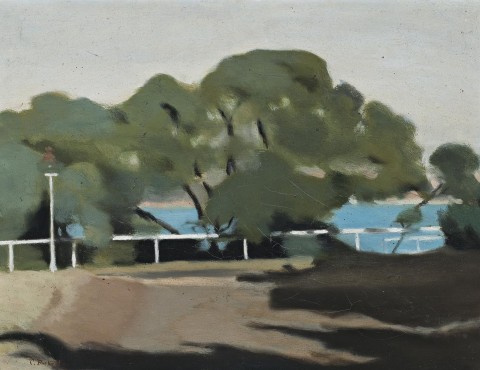RICKETTS POINT, BEAUMARIS, c.1920
CLARICE BECKETT
oil on canvas
36.0 x 45.5 cm
signed lower left: C. Beckett
bears inscription verso: Beckett / …
Private collection
Christie’s, Melbourne, 27 April 1999, lot 3 (as ‘Ricketts Point’)
Private collection, Melbourne
Beaumaris Foreshore, c.1926, oil on canvas, 45.5 x 51.0 cm, in the collection of the Art Gallery of New South Wales, Sydney
‘… She saw in soft focus and there were no edges in her work. She was concerned with achieving an harmonic atmospheric unity and the fairly consistent lack of brushstrokes makes the paint appear to float on the surface of the canvas … While many paintings were completed in situ, many others were worked upon indoors, taken from colour notations, sketches and memory with later imaginative touches’.1
Upon moving with her family to the Melbourne bayside suburb of Beaumaris in 1919, Clarice Beckett was irresistibly drawn to the sea in all its myriad moods and seasons – thus discovering a rich and endless source of inspiration for her painting in the surrounding coastal landscapes of Ricketts Point, Black Rock, Sandringham and Brighton. As the unmarried dutiful daughter however, responsibility for the care of her failing parents fell solely to her and accordingly, Beckett’s artistic endeavours were restricted to before and after her domestic duties. Indeed, it is testament to Beckett’s passion to paint and unwavering determination to succeed as a professional artist that not only did she continue to paint almost every day, spreading her practice over six hours early each morning and again, late into the evening. Moreover, when her father refused her a dedicated studio claiming ‘the kitchen table would do’, Beckett responded by constructing a small cart to wheel her painting materials around the cliffs and streets of Beaumaris and the neighboring suburbs.2 Her first solo exhibition was held at the Athenaeum Gallery, Melbourne in 1923 and, in another measure of her drive and commitment, she continued to exhibit there annually throughout the next decade before her premature death in 1935 from pneumonia.
Yet despite such limitations that seem unbearable from a contemporary perspective, Beckett herself did not seem to feel constrained in terms of her art – to the contrary, as Drusilla Modjeska suggests, she embraced such ‘edges’ as her own. ‘Why would I wish to go somewhere else strange …’, she is reported to have exclaimed when asked why she didn’t travel overseas, ‘I’ve only just got the hang of painting Beaumaris’.3 With its soft-focus realism, disarming simplicity and insubstantial, almost ethereal quality, Rickett’s Point, Beaumaris, c.1920 demonstrates eloquently Beckett’s mastery of such seaside landscapes. Employing very little paint confidently placed, thus Beckett here exploits to the full the lyrical potential of colour, light, rhythm and tone to imbue the immediate surrounds of her Beaumaris home with a beauty and sensibility that is unmistakably reminiscent of the music harmonies she so admired; as Beckett mused, ‘My pictures, like music, should speak for themselves’.4
Whether capturing the sparkling sunlight on bayside sands, the majesty of stormy seas, or pedestrian bathing boxes, Beckett possessed the remarkable ability to gently transform the most insignificant, fleeting of impressions into monumental visions’5, the prosaic into the poetic. Engaging with the ambiguity of ‘exact illusion’, thus Ricketts Point, Beaumaris offers a stunning example of Beckett’s meditations upon the beauty of the transient moment in a modern world. Elegant and lyrical, the work transcends the mundane reality of her subject to present a profoundly moving visual statement derived rather from ‘emotion recollected in tranquility’6 – as Wordsworth so famously wrote of his own poetry.
1. Hollinrake, R., Clarice Beckett: Politically Incorrect, exhibition catalogue, The Ian Potter Museum of Art, Melbourne, 1999, p. 17
2. ibid., pp.14 – 15
3. Beckett quoted in Modjeska, D., ‘Clarice Beckett: At the Edge’ in Clarice Beckett, exhibition catalogue, Niagara Galleries, Melbourne, 2014, p. 2
4. Beckett quoted in Hollinrake, op. cit., p. 19
5. Hollinrake, ibid., p. 18
6. Wordsworth, W., Lyrical Ballads, 1802
VERONICA ANGELATOS
